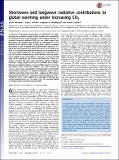| dc.contributor.author | Donohoe, Aaron | |
| dc.contributor.author | Armour, Kyle | |
| dc.contributor.author | Pendergrass, Angeline G. | |
| dc.contributor.author | Battisti, David S. | |
| dc.date.accessioned | 2015-06-02T16:58:06Z | |
| dc.date.available | 2015-06-02T16:58:06Z | |
| dc.date.issued | 2014-11 | |
| dc.date.submitted | 2014-07 | |
| dc.identifier.issn | 0027-8424 | |
| dc.identifier.issn | 1091-6490 | |
| dc.identifier.uri | http://hdl.handle.net/1721.1/97154 | |
| dc.description.abstract | In response to increasing concentrations of atmospheric CO[subscript 2], high-end general circulation models (GCMs) simulate an accumulation of energy at the top of the atmosphere not through a reduction in outgoing longwave radiation (OLR)—as one might expect from greenhouse gas forcing—but through an enhancement of net absorbed solar radiation (ASR). A simple linear radiative feedback framework is used to explain this counterintuitive behavior. It is found that the timescale over which OLR returns to its initial value after a CO[subscript 2] perturbation depends sensitively on the magnitude of shortwave (SW) feedbacks. If SW feedbacks are sufficiently positive, OLR recovers within merely several decades, and any subsequent global energy accumulation is because of enhanced ASR only. In the GCM mean, this OLR recovery timescale is only 20 y because of robust SW water vapor and surface albedo feedbacks. However, a large spread in the net SW feedback across models (because of clouds) produces a range of OLR responses; in those few models with a weak SW feedback, OLR takes centuries to recover, and energy accumulation is dominated by reduced OLR. Observational constraints of radiative feedbacks—from satellite radiation and surface temperature data—suggest an OLR recovery timescale of decades or less, consistent with the majority of GCMs. Altogether, these results suggest that, although greenhouse gas forcing predominantly acts to reduce OLR, the resulting global warming is likely caused by enhanced ASR. | en_US |
| dc.description.sponsorship | United States. National Oceanic and Atmospheric Administration (Global Change Fellowship) | en_US |
| dc.description.sponsorship | James S. McDonnell Foundation (Postdoctoral Fellowship) | en_US |
| dc.language.iso | en_US | |
| dc.publisher | National Academy of Sciences (U.S.) | en_US |
| dc.relation.isversionof | http://dx.doi.org/10.1073/pnas.1412190111 | en_US |
| dc.rights | Article is made available in accordance with the publisher's policy and may be subject to US copyright law. Please refer to the publisher's site for terms of use. | en_US |
| dc.source | National Academy of Sciences (U.S.) | en_US |
| dc.title | Shortwave and longwave radiative contributions to global warming under increasing CO[subscript 2] | en_US |
| dc.type | Article | en_US |
| dc.identifier.citation | Donohoe, Aaron, Kyle C. Armour, Angeline G. Pendergrass, and David S. Battisti. “Shortwave and Longwave Radiative Contributions to Global Warming Under Increasing CO[subscript 2].” Proceedings of the National Academy of Sciences 111, no. 47 (November 10, 2014): 16700–16705. | en_US |
| dc.contributor.department | Massachusetts Institute of Technology. Department of Earth, Atmospheric, and Planetary Sciences | en_US |
| dc.contributor.mitauthor | Donohoe, Aaron | en_US |
| dc.contributor.mitauthor | Armour, Kyle | en_US |
| dc.relation.journal | Proceedings of the National Academy of Sciences | en_US |
| dc.eprint.version | Final published version | en_US |
| dc.type.uri | http://purl.org/eprint/type/JournalArticle | en_US |
| eprint.status | http://purl.org/eprint/status/PeerReviewed | en_US |
| dspace.orderedauthors | Donohoe, Aaron; Armour, Kyle C.; Pendergrass, Angeline G.; Battisti, David S. | en_US |
| mit.license | PUBLISHER_POLICY | en_US |
| mit.metadata.status | Complete | |
